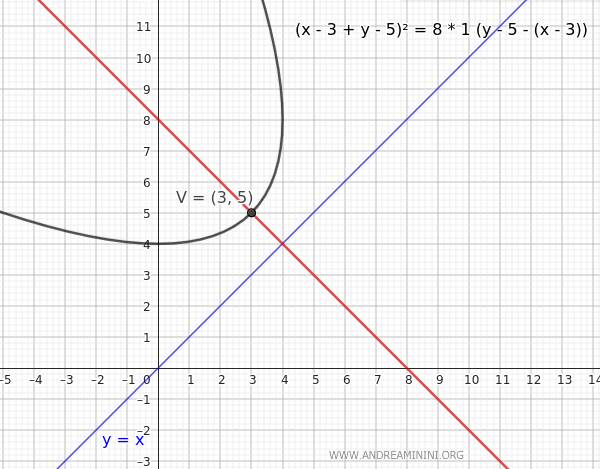Equation of a Rotated Parabola with an Oblique Axis
To describe a parabola with its vertex at \( (h, k) \) and an axis of symmetry inclined at an angle \(\alpha\), we need to recognize that a parabola with an inclined axis results from an isometric rotation.
For example, if we rotate the coordinates of a point (x,y) by an angle \(-\alpha\), we obtain new coordinates (x',y'):
$$ x' = (x - h) \cos(\alpha) + (y - k) \sin(\alpha) $$
$$ y' = -(x - h) \sin(\alpha) + (y - k) \cos(\alpha) $$
Thus, if the original equation of the parabola with its axis parallel to the y-axis is:
$$ y = ax^2 $$
The parabola in the new coordinates \( (x', y') \) has the standard equation:
$$ y' = a (x')^2 $$
Substituting \( x' \) and \( y' \) into the equation $ y' = a (x')^2 $, we obtain the rotated equation:
$$ -(x - h) \sin(\alpha) + (y - k) \cos(\alpha) = a \left[ (x - h) \cos(\alpha) + (y - k) \sin(\alpha) \right]^2 $$
If the original parabola is given in the canonical form with a vertical axis, \( (x - h)^2 = 4p(y - k) \), after rotation by \(\alpha\), the equation becomes:
$$ (x' - h)^2 = 4p(y' - k) $$
Substituting the rotated coordinates $ x' $ and $ y' $, we get:
$$ \left[(x - h) \cos(\alpha) + (y - k) \sin(\alpha)\right]^2 = 4p \left[-(x - h) \sin(\alpha) + (y - k) \cos(\alpha)\right] $$
These are the equations for the rotated parabola.
A Practical Example
Consider a parabola with its vertex at $ V(h,k)=(3,5) $ and inclined at an angle of 45°, which means \(\alpha = 45^\circ\) or \(\alpha = \frac{\pi}{4}\):
The equation of the rotated parabola is:
$$ \left[(x - h) \cos(\alpha) + (y - k) \sin(\alpha)\right]^2 = 4p \left[-(x - h) \sin(\alpha) + (y - k) \cos(\alpha)\right] $$
Substituting $ h=3 $, $ k=5 $, and $ \alpha=45° $:
$$ \left[(x - 3) \cos(45°) + (y - 5) \sin(45°)\right]^2 = 4p \left[-(x - 3) \sin(45°) + (y - 5) \cos(45°)\right] $$
Knowing that $ \cos(45^\circ) = \sin(45^\circ) = \frac{1}{\sqrt{2}} $, the equation becomes:
$$ \left[(x - 3) \frac{1}{\sqrt{2}} + (y - 5) \frac{1}{\sqrt{2}}\right]^2 = 4p \left[-(x - 3) \frac{1}{\sqrt{2}} + (y - 5) \frac{1}{\sqrt{2}}\right] $$
Simplifying the terms, we get:
$$ \left[(x - 3) + (y - 5)\right]^2 = 8p \left[(y - 5) - (x - 3)\right] $$
Expanding and simplifying further, we derive the correct equation for the rotated parabola.

And so on.
